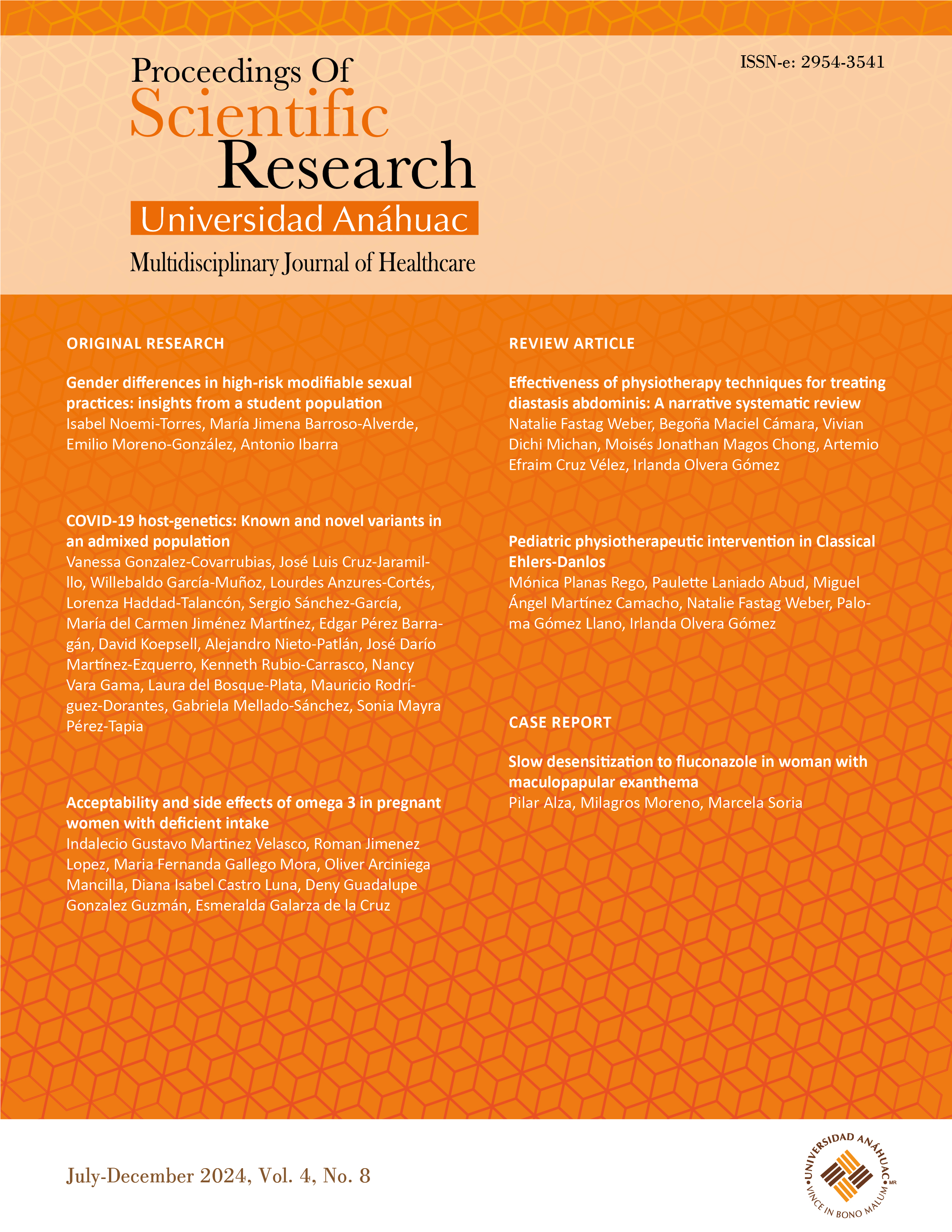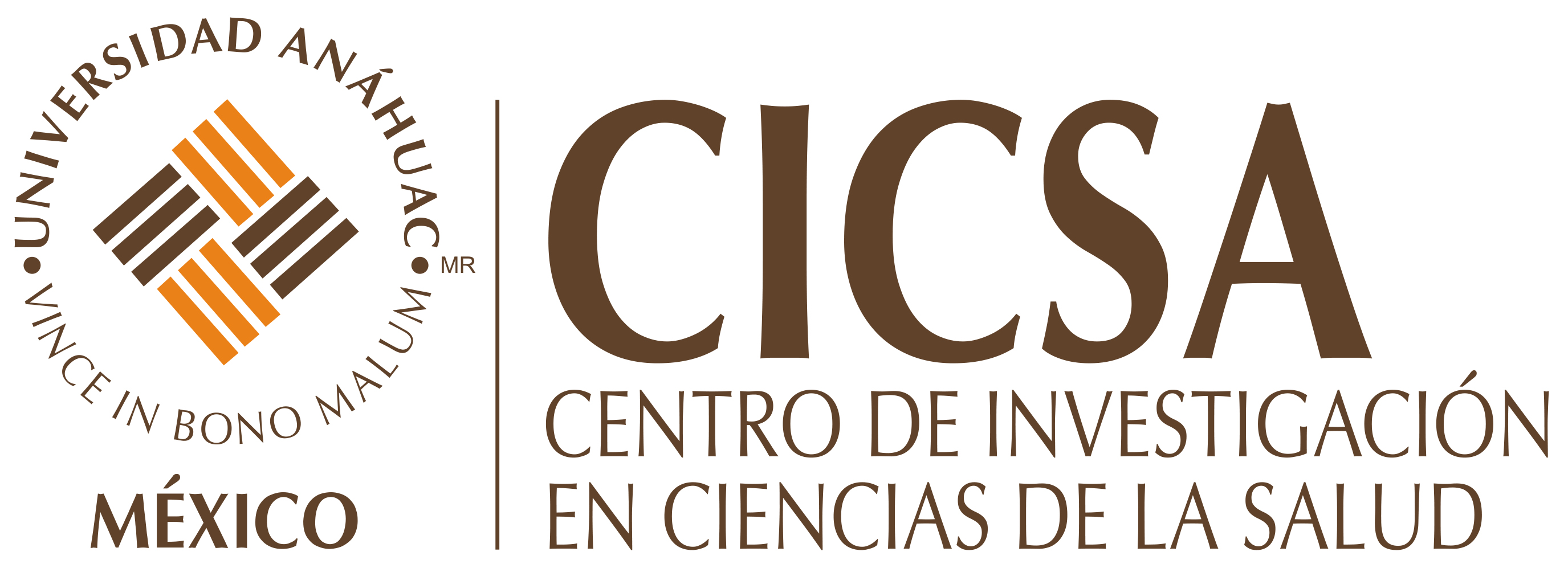Acceptability and side effects of omega 3 in pregnant women with deficient intake
DOI:
https://doi.org/10.36105/psrua.2024v4n8.03Keywords:
Preterm Birth, Omega-3, Pregnancy, Food Frequency Questionnaire, fish, Docosahexaenoic acidAbstract
Introduction: Omega-3 polyunsaturated fatty acids, such as EPA and DHA, are essential during pregnancy due to their benefits for maternal health and fetal development. In pregnant women with omega-3 deficiency, assessing tolerability, acceptability, and potential side effects is crucial to optimize treatment adherence. Objective: To determine the tolerability and the main side effects in a group of pregnant women with inadequate fish intake in a rural community. Materials and methods: A nutritional survey was conducted in a group of pregnant women attending their prenatal check-ups at a private Gyneco-obstetric institution to investigate the need for omega-3 supplementation through a simplified questionnaire in a population of pregnant women. Two capsules containing 760 mg of EPA and 520 mg of DHA were prescribed from 20 weeks onward. The presence of side effects and adherence to the prescription were documented. Results: A tolerability rate of 100.0% was found. Side effects included nausea 19.2%, belching 4.6%, fishy breath 2.3%, vomiting 1.5%, and no cases of allergic reaction. No patient discontinued supplementation. Conclusions: The side effects of omega-3 PUFAs in this study were very low, resulting in excellent treatment adherence.
Downloads
PLUMX metrics
References
Calder PC. Very long-chain n-3 acids and human health: fact, fiction, and the future. Proc Nutr Soc. 2018;77:57-72. https://doi.org/10.1017/S0029665117003950
The Lancet [Internet]. Executive Summary of the Lancet Maternal and Child Nutrition Series; c2013. [Cited 2020 Jan 14]. Available at: https://www.thelancet.com/pb/assets/raw/Lancet/stories/series/nutrition-eng.pdf
Danielewicz H, Myszczyszyn G, Debinska A, Myszkal A, Boznanski A, Hirnle L. Diet in Pregnancy—More than food. Eur J Pediatr. 2017;176:1573–1579. https://doi.org/10.1007/s00431-017-3026-5
Gow RV, Hibbeln JR. Omega-3 Fatty Acid and nutrient deficits in adverse neurodevelopment and childhood behaviors. Child Adolesc Psychiatr Clin N Am. 2014;23:555–590. https://doi.org/10.1016/j.chc.2014.02.002
Parra-Cabrera S, Stein AD, Wang M, Martorell R, Rivera, J, Ramakrishnan U. Dietary intakes of polyunsaturated fatty acids among pregnant Mexican women: PUFA intakes of Mexican pregnant women. Matern Child Nutr. 2011;7(2), 140–147. https://doi.org/10.1111/j.1740-8709.2010.00254.x
Shen Y, Zheng L, Jin J, Li X, Fu J, Wang M, et al. Phytochemical and biological characteristics of Mexican Chia seed oil. Molecules. 2018; 23(12), 3219. https://doi.org/10.3390/molecules23123219
Oken E, Musci RJ, Westlake M, Gachigi K et al. Demographic and health characteristics associated with fish and n-3 fatty acid supplement intake during pregnancy: results from pregnancy cohorts in the ECHO programme. Public Health Nutrition. 2024;27(1):e94. https://doi.org/10.1017/S136898002400051X
Al-Hinai M, Baylin A, Tellez-Rojo MM, Cantoral A, Ettinger A, Solano M, et al. Maternal intake of omega-3 and omega-6 polyunsaturated fatty acids during mid-pregnancy is inversely associated with linear growth. J Dev Orig Health Dis. 2018;9(4):432-441. https://doi.org/10.1017/S2040174418000193
Swanson D, Block R, Mousa SA. Omega-3 fatty acids EPA and DHA: Health benefits throughout life. Adv Nutr. 2012;3:1-7. https://doi.org/10.3945/an.111.000893
Burdge GC, Wootton SA. Conversion of Alpha-linolenic acid to eicosapentanoic, docosapentanoic and docosahexanoic acids in Young women. Br J Nutr. 2002; 88:411-420. https://doi.org/10.1079/bjn2002689
Cai F, Young BK, Mccoy A. Commercially available prenatal vitamins do not meet American College of Obstetricians and Gynecologists nutritional guidelines. Am J Perinatol. 2023 Jul 7;41(Suppl 1):e2547–e2554. https://doi.org/10.1055/a-2125-1148
Freeman MP, Shinja P. Tolerability of omega-3 fatty acid supplements in perinatal women. Prostaglandins, Leukotriens and essential fatty acids 2007;77: 203-208. https://doi.org/10.1016/j.plefa.2007.09.004
Middleton P, Gomersall JC, Gould JF, Shepherd E, Olsen S, Makrides M. Omega-3 fatty acid addition during pregnancy. Cochrane Database Syst Rev. 2018; 11(11): CD003402. https://doi.org/10.1002/14651858.CD003402.pub3
US Department of Agriculture & US Department of Health and Human Services [Internet]. Dietary Guidelines for Americans, 2020-2025; c2020 [Cited 2024 July]. Available at: https://dietaryguidelines.gov/resources/2020-2025-dietary-guidelines-online-materials
Thompson M, Hein N, Hanson C, Smith L. Anderson A, Ritcher C, et al. Omega-3 fatty acid intake by age, gender, and pregnancy status in the United States: national health and nutrition examination survey 2003–2014. Nutrients. 2019; 15;11(1):177 https://doi.org/10.3390/nu11010177
Al-Hinai M, Baylin A, Tellez-Rojo MM, Cantoral A, Ettinger A, Solano M, et al. Maternal intake of omega-3 and omega-6 polyunsaturated fatty acids during mid-pregnancy is inversely associated with linear growth. J Dev Orig Health Dis. 2018;9(4):432-441. https://doi.org/10.1017/S2040174418000193
Perez-Rodrigo C, Aranceta J, Salvador G, Varela-Moreiras G. Food Frequency Questionnaires. Nutr Hosp. 2015;31 (Suppl 3):49-56. https://doi.org/10.3305/nh.2015.31.sup3.8751
Cade J, Thompson R,Burley V, Warm D. Development, validation and utilisation of food questionnaires -a review. Public Health Nutr. 2002;5(4):567-87. https://doi.org/10.1079/PHN2001318
Parker G, McClure G, Hegarty BD, Smith IG. The validity of a food frequency questionnaire as a measure of PUFA status in pregnancy. BMC Pregnancy Childbirth. 2015;15:60. https://doi.org/10.1186/s12884-015-0494-3
Parra MS, Schnaas L, Meydani M, Perroni E, Martínez S, Romieu I. Erythrocyte cell membrane phospholipid levels compared against reported dietary intakes of polyunsaturated fatty acids in pregnant Mexican women. Public Health Nutr. 2002; 5(6A):931–7. https://doi.org/10.1079/PHN2002381
Olsen SF, Hansen HS, Sandstróm B, Jensen B. Erythrocyte levels compared with reported dietary intake of marine n-3 fatty acids in pregnant women. Br J Nutr. 1995;73:387-95. https://doi.org/10.1079/BJN19950041
Herter-Aeberli I, Graf C, Vollenweider A, et al. Validation of a food frequency questionnaire to assess n-3 polyunsaturated fatty acids intake in Switzerland. Nutrients. 2019;11(8):1863. https://doi.org/10.3390/nu11081863
Zhou YB, Li HT, Trasande L, Wang L, Zhang Y, Bai M, et al. A correlation study of DHA intake estimated by an FFQ and concentrations in plasma and erythrocytes in mid-and late pregnancy. Nutrients. 2017;9:1256. https://doi.org/10.3390/nu9111256
Kobayashi M, Jwa SC, Ogawa K, Morisaki N, Fujiwara T. Validity of a food frequency questionnaire to estimate long-chain polyunsaturated fatty acid intake among Japanese women in early and late pregnancy. J Epidemiol. 2017;27(1):30–5. https://doi.org/10.1016/j.je.2016.07.001
Crawford SA, Christifano DN, Kerlinga EH, Gajewski BJ, Valentine CJ, Gustafson KM, et al. Validation of an Abbreviated Food Frequency Questionnaire for Estimating DHA Intake of Pregnant Women in the United States. Prostaglandins Leukot Essent Fatty Acids. 2022; 177:102398. https://doi.org/10.1016/j.plefa.2022.102398
Christifano DN, Crawford SA, Lee G, Gajewski BJ, Carlson SE. Utility of a 7- 7-question online screener for DHA intake. Prostaglandins Leukot Essent Fatty Acids. 2022 177:102399. https://doi.org/10.1016/j.plefa.2022.102399
National Institute for Health and Care Excellence (NICE) [Internet]. Omega-3-acid ethyl esters London: British National Formulary (BNF); c2025 [cited 2025 Feb 1]. Available at: https://bnf.nice.org.uk/drug/omega-3-acid-ethyl-esters.html.
Elgar K. EPA/DHA: A Review of Clinical Use and Efficacy. Nutr. Med J. 2022; 1(2): 97-132.
Cheng-Ho C. Safety and tolerability of prescription omega-3 fatty acids: A systematic review and meta-analysis of randomized controlled trials. Prostaglandins Leukot Essent Fatty Acids. 2018; 129:1-12. https://doi.org/10.1016/j.plefa.2018.01.001
Rasmussen K, Catalano PM, Yaktine AL. New guidelines for weight gain during pregnancy: what obstetrician/ gynecologists should know. Current Opin Obstet Gynecol 2009;21(6):521-26. https://doi.org/10.1097/GCO.0b013e328332d24e
The American College of Obstetrics and Gynecology [Internet]. Nutrition during pregnancy: Frequently Asked Question; c2022 [Cited 2024 Jan 5]. Available at: https:// www.acog.org/womens-health/faqs/nutritionduring-pregnancy
Australian Government Department of Health and Aged Care [Internet]. Pregnancy care guidelines; c2020. [Cited 2024 Jan 5] Available at: https://www.health.gov.au/resources/pregnancy-care-guidelines

Downloads
Published
How to Cite
Issue
Section
License
Copyright (c) 2024 Indalecio Gustavo Martinez Velasco, Roman Jimenez Lopez, Maria Fernanda Gallego Mora, Oliver Arciniega Mancilla, Diana Isabel Castro Luna, Deny Guadalupe Gonzalez Guzmán, Esmeralda Galarza de la Cruz

This work is licensed under a Creative Commons Attribution-NonCommercial-NoDerivatives 4.0 International License.
All the intellectual content found in this publication is licensed to the consumer public under the figure of Creative Commons©, unless the author of said content has agreed otherwise or limited said faculty to "Proceedings of Scientific Research Universidad Anáhuac. Multidisciplinary Journal of Healthcare©" or "Universidad Anáhuac Mexico©" in writing and expressly.
Proceedings of Scientific Research Universidad Anáhuac. Multidisciplinary Journal of Healthcare is distributed under a Creative Commons Attribution-NonCommercial-NoDerivatives 4.0 International License.
The author retains the economic rights without restrictions and guarantees the journal the right to be the first publication of the work. The author is free to publish his article in any other medium, such as an institutional repository.












